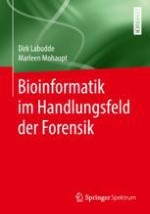2018 | OriginalPaper | Buchkapitel
8. Genetischer Fingerabdruck – Charakteristik und Methoden
verfasst von : Dirk Labudde, Marleen Mohaupt
Erschienen in: Bioinformatik im Handlungsfeld der Forensik
Verlag: Springer Berlin Heidelberg
Aktivieren Sie unsere intelligente Suche, um passende Fachinhalte oder Patente zu finden.
Wählen Sie Textabschnitte aus um mit Künstlicher Intelligenz passenden Patente zu finden. powered by
Markieren Sie Textabschnitte, um KI-gestützt weitere passende Inhalte zu finden. powered by
